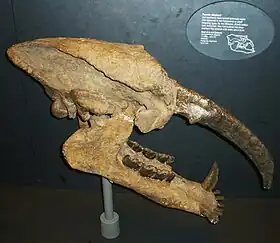Astrapotheria
Les Astrapotheria constituent un ordre éteint de mammifères ongulés qui a vécu du Paléocène au Miocène.

Crâne fossilisé d‘Astrapotherium magnum trouvé en Patagonie, vieux de 17 millions d'années (Miocène inférieur), décrit comme un « pseudo-éléphant » (Musée d'histoire naturelle de Londres).
Phylogénie
|
Eoastrapostylops | |||||||||||||||||||||||||||||||||||||||||||||||||||||||||||||||||||||||||||||||
| |||||||||||||||||||||||||||||||||||||||||||||||||||||||||||||||||||||||||||||||
Galerie photographique
 Reconstitution de Trigonostylops.
Reconstitution de Trigonostylops. Reconstitution d’Astrapotherium magnum.
Reconstitution d’Astrapotherium magnum.
Bibliographie
- (en) M. C. Vallejo-Pareja, J. D. Carrillo, J. W. Moreno-Bernal, M. Pardo-Jaramillo, D. F. Rodriguez-Gonzalez and J. Muñoz-Duran (2015). "Hilarcotherium castanedaii, gen. et sp. nov., a new Miocene astrapothere (Mammalia, Astrapotheriidae) from the Upper Magdalena Valley, Colombia" (PDF). Journal of Vertebrate Paleontology. 35 (2): e903960. doi:10.1080/02724634.2014.903960.
Notes et références
Liens externes
- Ressources relatives au vivant :
- Portail de la paléontologie
- Portail des mammifères
- Portail du Cénozoïque
Cet article est issu de Wikipedia. Le texte est sous licence Creative Commons – Attribution – Partage à l’identique. Des conditions supplémentaires peuvent s’appliquer aux fichiers multimédias.